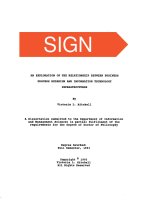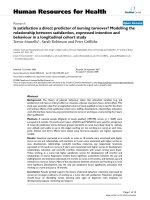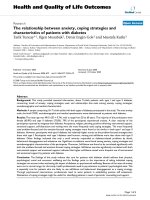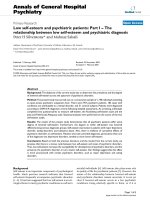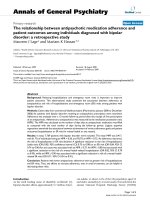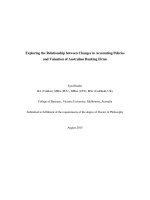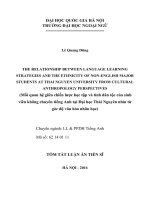The relationship between inovation in services and standardization emperial evidence of services provides invovement
Bạn đang xem bản rút gọn của tài liệu. Xem và tải ngay bản đầy đủ của tài liệu tại đây (1.16 MB, 37 trang )
The relationship between innovation
in services and standardization:
Empirical evidence of service
providers’ involvement in
standardization
Paul Wakkea, Knut Blinda, b, c, Henk J. de Vriesb
a
Chair of Innovation Economics, Berlin University of Technology
(Postal address: VWS 2, Mueller-Breslau-Straße 15, 10623 Berlin, Germany)
b
c
Endowed Chair of Standardization, Rotterdam School of Management, Erasmus University
(Postal address: Burgemeester Oudlaan 50, 3062 PA, Rotterdam, The Netherlands)
Fraunhofer Institute for Open Communication Systems (FOKUS) (Postal address: KaiserinAugusta-Allee 31, 10589 Berlin, Germany)
Email addresses: , ,
Corresponding author: Paul Wakke, , Tel: +493031476631, Fax:
+493031476628
Electronic
Electroniccopy
copyavailable
availableat:
at: /> />
Abstract
Extant research suggests a positive and bidirectional relation between innovation and
standardization. Focusing on the service industries, this paper relates the theory of innovation
in services to the participation of service providers in standardization committees. For this
purpose, we review the literature and identify three different patterns of service innovation.
Subsequently, we analyze the committee structure of the national standards bodies of the
Netherlands (NEN) and Germany (DIN) by applying the industry classification NACE and
the standards classification ICS. The analysis reveals that standardization is of vital
importance for the service industries. Interestingly, the service industries in both countries use
standardization primarily for technology-related service innovations rather than for service
standardization in consequence of “innovation in services”. Doing so, service providers
largely focus on standardizing technologies from the manufacturing industries in order to
expedite “supplier dominated innovation”. Moreover, certain service industries develop
technologies themselves and perform “innovation through services”. These service industries
are strongly overrepresented in the standardization committees. As for these industries,
standardization represents an appropriate mean to speed up market access and diffusion of
their innovations. Our findings suggest that policy makers can stimulate innovation in
services by promoting the service industries’ participation in standardization.
Keywords: Innovation in services, standards, standardization, technology transfer and
diffusion
Electronic
Electroniccopy
copyavailable
availableat:
at: /> />
1
Introduction
Innovation implies the successful creation of something new, and standards by definition
“freeze” a solution for a certain amount of time, so there is an inherent tension between
standards and innovation. Standardization may be accused of hindering innovation.
Nevertheless, research provides evidence that standardization may also stimulate innovation.
Hence, companies may innovate more successfully by participating in committees that
prepare standards, and policy makers may promote standards as instruments to stimulate
innovation.
So far, research on the relation between standardization and innovation focused on technical
standards and technical innovation. Indeed, most standards are technical standards and
innovation performance measured using patents as an indicator finds a vast majority of
technical innovation. However, services have a major and growing share in most economies.
Therefore, this paper seeks to investigate the relation between innovation and standardization
in service industries. In response to the growing significance of the service industries,
standardization has extended its so far rather technical scope towards services and set up
several service standards at national, European, and international levels for different service
industries, such as transport, translation services or maintenance. Thereby, service standards
may be used to improve the service process, the communication between provider and
customer as well as the service result. However, also technical standards are relevant for the
service industries.
The provision of services is often effectuated by technologies or even leads to technologies as
in the case of engineering services. Accordingly, the service industries might be interested not
only in standardizing services but in technical standardization as well. We recognize that
technological innovations also apply to service providers upon which they improve or even
Electronic copy available at: />
build their services. The well-known MP3 audio format, specified within the international
standards ISO/IEC 11172-3 and ISO/IEC 13818-3, led to several service innovations (e.g.,
online stores for music or podcasting). The radio-frequency identification (RFID) technology
represents a similar example within logistics and retail. However, some service industries,
such as certain engineering services, provide the service of designing technologies. As for
these companies, standardization might be used as an appropriate mean to speed up market
access and diffusion of their technologies.
The paper on hand seeks to take these different types of innovation and standardization
activities in the service industries into account by relating the companies’ industry
classification (manufacturers vs. service providers) to their involvement in standards
committees (focusing on product and service standardization). Thereby, we focus on the
involvement in de jure standardization at national standards bodies (NSBs) as opposed to de
facto standardization. In the latter case, the standard arises from a standardization struggle
(and sometimes from a standard war) between different solutions of different firms or
coalitions (Chiesa and Toletti, 2003). In contrast, de jure standardization is defined by the
existence of independent organizations and partly by the promulgation of standards by
legislative bodies as in the case of mandated standards (David and Greenstein, 1990). More
detailed, we consider the committees of the Dutch (NEN1) and German (DIN2) NSBs and
apply the industry classification NACE3 and the standards classification ICS4 to distinguish
service industries from other industries and service standards from other standards.
The paper’s contribution stems from bridging two existing disciplines, standardization and
innovation, in the realm of services. Therewith, it responds to the significance of the service
1
Dutch: Nederlands Normalisatie-instituut (Netherlands Standardization Institute)
German: Deutsches Institut für Normung e. V. (German Institute for Standardization)
3
French: Nomenclature statistique des Activités économiques dans la Communauté Européenne (Statistical Classification of
Economic Activities in the European Community)
4
International Classification for Standards
2
Electronic copy available at: />
industries within today’s modern economies and tries to provide new insights concerning the
“assimilation/demarcation/synthesis” discussion (Gallouj and Windrum, 2009) about whether
service innovation is fundamentally different to innovation in manufacturing industries or not.
Furthermore, new insights into the promising and new field of service standardization are
expected.
The remainder of the paper is structured as follows: Section 2 theoretically considers the
relation between innovation and standardization (2.1) and elaborates different patterns of
service innovation from the extant literature (2.2). Section 3 provides the empirical analysis
and starts with introducing the methodology used to identify the different patterns of service
innovation within standardization (3.1). Subsection 3.2 analyzes to what extent the different
service industries participate in standardization. Subsequently, the different patterns of service
innovation are related to standardization in Subsection 3.3 and 3.4. Thereby, Subsection 3.3
focuses on the committee structure and Subsection 3.4 on the output of these committees (i.e.,
the standards) using the standards classification ICS.
Finally, Section 4 discusses the empirical findings, while Section 5 derives implications and
provides the limitations of the paper’s findings.
Electronic copy available at: />
2
Theoretical considerations
2.1
The relation between innovation and standardization
The extant research suggests a positive relation between standardization and innovation. As
for standards (the output of standardization), Blind (2003) provides hints for the
complementarity rather than the contradiction between innovation and standards. Swann
(2010) offers a comprehensive summary of literature dealing with the question of whether
standards enable or constrain innovation. Basically, the codification and diffusion of the
current state of technology assists the translation of research results into marketable products
and services so that standards may foster innovation. However, standards might also constrain
at the same time (Allen and Sriram, 2000; Swann and Lambert, 2010), while sometimes
constraints are useful to “reduce undesirable outcomes” (Swann, 2010, p. 9). As for service
standards in particular, De Koning and De Vries (2009) conclude that standards may
positively impact innovation in services based on a case study in Facility Management.
However, hardly any studies are available for the effect of service standards on innovation.
As for the standard setting process, innovation can also be regarded as necessary precondition
for bringing in own knowledge into standardization or more generally for the engagement in
collaborations (Fritsch and Lukas, 2001). In principle, standard setters aim at adapting the
standard content to their benefit in order “to minimize the technical distance between the
standard itself and the present technical specifications of each firm’s current product and
processes” (Antonelli, 1994, p. 200). Moreover, Berger et al. (2011) evidenced the use of
standardization to have own intellectual property rights (e.g., patents) included in the
standard. In any case, innovation activities foster standardization for reasons of diffusion and
commercialization of these innovations. Accordingly, Blind (2002 & 2006a) proved a positive
effect of innovation activities on standardization for the manufacturing industries using patent
Electronic copy available at: />
applications at industry level in 2002 and research and development (R&D) expenses at firm
level in 2006 as indicator for innovation. Regarding the participation of service providers,
Blind et al. (2012) as well as Blind and Mangelsdorf (2010) evidenced a positive relationship
between innovation activities and standardization. Thereby, Blind et al. (2012) extended this
linear relation towards an inversed U-shape so that highly innovative service providers are
rather reluctant to standardize probably due to intellectual property concerns. An alternative
explanation for this behavior would be a strong market position so that these highly
innovative companies do not need the support of standards to market their products
successfully (Blind and Thumm, 2004).
A third line of argumentation is the effect of participation within standardization on the
innovativeness of the participants. Within standards committees, companies’ delegates meet
colleagues from competitors, customers, suppliers, testing organizations, governments, nongovernmental organizations, and other stakeholders in a rather informal setting. Hence,
standardization can be regarded as collaboration between the different participants (Tether,
2002), which promotes knowledge exchange or even knowledge generation. According to the
relational view (Dyer and Singh, 1998), this generates interfirm resources leading to more
innovation (Love and Roper, 1999) and resulting in “interorganizational competitive
advantages”. Therefore, standardization might foster the innovativeness of its participants.
However, only very few and rather anecdotal evidence of this argumentation can be found
within literature (Blind 2006a; Wakke and Blind, 2012), while several scholars highlighted
the general role of networks, communities, and linkages as alternatives to internal innovation
activities (von Hippel, 1988; Chesbrough, 2003).
In conclusion, there is a bidirectional relation between innovation and standardization in
theory. Thus, we assume that the service providers’ involvement within standardization is
related to some sort of innovation in services. The following section aims at reviewing the
Electronic copy available at: />
literature on innovation in services in order to elaborate different patterns of service
innovation. Drawing upon the theory of innovation in services, we then apply the
standardization behavior of the service industries to this theory.
2.2
Different patterns of service innovation
Innovation activities in the service industries is a rather young and largely unexplored
research field to date. The following paragraphs summarize different schools of thought
within extant literature. Barras (1986) proposed the “reverse product cycle” to shed some light
on the transmission process by which a new technology is taken up by the service industries.
Based on an empirical study of the adoption of information technology in different service
industries, he suggests that, firstly, existing services become more efficient due to the
adoption of a new technology, then the quality improves, and finally, wholly transformed or
even new services arise.
Droege and Hildebrand (2009) provide a review of the literature in the field of innovation in
services and call this thinking of Barras and other scholars (Gallouj and Weinstein, 1997;
Miozzo and Soete, 2001) the “technologist perspective”. Basically, this perspective is
comparable to the assimilation viewpoint that calls for assimilating service innovation to
existing theories derived from manufacturing industries (Gallouj and Windrum, 2009).
Indeed, there are several examples for the interaction between product and service innovation.
With new materials it was possible to innovate several service industries such as shipping or
surgery. New appliances enabled ATMs5, automated washing systems or car parks (Meiren,
2009). Information technology and appropriate infrastructures have made telemedicine an
increasingly viable health care service delivery alternative (Sheng et al., 1999). A new field of
research developed around the so-called self-service technologies (SST) including the
5
Automated teller machines
Electronic copy available at: />
analysis of technology-based service encounters (Meuter et al., 2000). Additionally, providers
of learning services offer web-based lectures; remote services or cloud computing are other
examples that blur the inherent characteristics of services (e.g., the perishability or the
inseparability of production and consumption) more and more (Moeller, 2010).
Miozzo and Soete (2001) developed a taxonomy with regard to the source of technologies for
the service industries aiming at substantiating the service-specific research of Pavitt (1984).
The supplier-dominated sectors, which is their first group, largely use technologies from
manufacturing industries. Within the second group, the scale-intensive physical networks and
information networks sectors, innovation still originates in manufacturing firms, however,
“the nature of these innovations will be strongly determined by service use” (Miozzo and
Soete, 2001, p. 162). The science-based and specialized supplier sectors, which make up the
third group, mainly develop their technologies themselves by means of more or less
traditional R&D activities. Thus, service providers can broadly be subdivided into either
“technology-using” (supplier-dominated sectors and scale-intensive physical networks and
information networks sectors) or “technology-producing or -developing” (science-based
and specialized suppliers) (Droege and Hildebrand, 2009; Miozzo and Soete, 2001).
Vence and Trigo (2009) developed a typology of innovation patterns based on the existing
literature and came up with three different types: low innovation intensive sectors (wholesales
and commission trade as well as transport and communication), technology-intensive and
moderately innovation-intensive sectors (financial intermediation), and knowledge and
innovation-intensive sectors (business services). With regard to the main source of
innovation, the first two types heavily rely on the acquisition of machinery and equipment
(technology-users) while the third type solely relies on “intramural R&D” (Vence and Trigo,
2009, p. 1652) and thus can be regarded as technology-developing.
Electronic copy available at: />
However, in recent years several scholars criticized this technological view as being to insular
and not taking all forms of service innovation into account (Hipp and Grupp, 2005; Gallouj,
2002, Gadrey et al., 1995). Thus, alongside the “technologist perspective”, scholars
meanwhile argue that service innovations are not necessarily linked to technology (Toivonen
and Tuominen, 2009; Hipp et al., 2000) or R&D (Miles, 2007). Barcet (2010) considers this
non-technological type of service innovation “service-based innovation” and states that
“relationships with clients and their consumption processes are becoming central” to this
concept of innovation (Barcet, 2010, p. 54). Djellal et al. (2003) emphasize the importance of
the social sciences and humanities alongside organizational aspects. All this thinking can be
combined within the demarcation viewpoint suggesting the existence of service-specific
innovation patterns as opposed to the assimilation view (Gallouj and Windrum, 2009).
Den Hertog (2000) considered service providers as co-producers of innovation and
highlighted their increasing importance in the innovation process. Thereby, he identified five
basic service innovation patterns that combine the “technologist perspective” and the
“service-based innovation perspective”. The first pattern is called “supplier dominated
innovation”, which corresponds to the first group of Miozzo and Soete (2001) and thus can
be regarded as technology-using. The second pattern is named “innovation in services” and
responds to the “service-based innovation” concept of Barcet (2010). The third pattern (clientled innovation) focuses on the client interface, which is included in the “service-based
innovation” concept of Barcet (2010). The fourth pattern is called “innovation through
services” and responds to the technology-developing aspect of Droege and Hildebrand
(2009). Finally, the fifth pattern (paradigmatic innovation) of Den Hertog (2000) particularly
deals with complex innovations affecting whole value chains. However, these paradigm shifts
are not considered in this paper. We relate service innovation to standardization in a rather
cross-sectional manner so that it would not be appropriate to explore dynamic paradigm
Electronic copy available at: />
shifts. Considering all the above mentioned and following a rather broad and integrative
approach, three patterns of service innovations (including the types of service providers) are
distinguished:
Pattern 1: Supplier dominated innovation (service providers using technology to
innovate),
Pattern 2: Innovation through services (service providers that develop innovative
technology themselves) and
Pattern 3: Innovation in services (service providers that innovate intangible elements of
their services).
Thereby, service providers might innovate according to different patterns simultaneously. An
engineering office certainly not only designs technologies but also uses technologies like
CAD6 systems (McDermott et al., 2001). Therefore, we consider the possibility of different
innovation activities within one company. The next section empirically investigates the
service providers’ involvement in standardization in order to substantiate the three different
patterns of service innovation within standardization using different data.
6
Computer-aided design
Electronic copy available at: />
3
Empirical evidence of service providers’ involvement in
standardization
3.1
Methodology
The empirical part of our study uses the databases of all participants of standards committees
of the NSBs of Germany (DIN) and the Netherlands (NEN). Information about the dataset is
provided in Table 1. Basically, 14,211 organizations (service providers and manufacturers)
active in 4,207 standards committees and holding 44,307 committee seats entered the
analysis.
Table 1: Overview of the two datasets and the respective NSB
NEN
DIN
Access to database
Mid 2009
Mid 2010
Organizations (in data)
2,679
11,532
Committees (in data)
795
3,412
Committee Seats (in data)
7,786
36,521
Average Committee Size (in data)
9.8 Seats
10.7 Seats
Staff (Annual report 2011)
315
568 (including subsidiaries)
Turnover (Annual report 2011)
€ 32 million
€ 100 million (including
subsidiaries)
These committees may develop national standards, but the major part of their work is to
prepare the national input for standardization at the European and international level so that
all levels of standardization are grasped. In order to link the elaborated patterns of service
innovation with the standardization behavior of service providers, the industry affiliation of
all committee members is considered using the industry classification NACE (Eurostat,
2011). Therewith, some general insights into the extent of the service providers’ involvement
within standardization are gained (see 3.2). Subsection 3.3 furthermore analyzes this extent
for each committee. Finally, the standards classification ICS is applied to the committee
structure. That way, we aim at determining which standards – technical standards or service
standards – are elaborated in which service industries (see 3.4).
Electronic copy available at: />
We regard the use of the industry classification as an appropriate mean to differentiate
between the first (supplier dominated innovation) and the second (innovation through
services) pattern of service innovation. Miozzo and Soete (2001, p. 162) state that software
and specialized business services can be considered as industries in which “the main sources
of technology are the research, development, and software activities of firms in the sector
itself”. Thus, we assume that this kind of service providers perform “innovation through
services” and can be assigned to our second service innovation pattern. According to Miozzo
and Soete (2001), all other service industries rely more or less on technologies provided by
the manufacturing industries so that the remaining industries can be assigned to the “supplier
dominated innovation” pattern.
After differentiating between the first two service innovation patterns, the standards
classification ICS is applied to differentiate between service standards and all other, rather
technical standards. The European standard EN 45020:2006 defines a service standard as a
“standard that specifies requirements to be fulfilled by a service, to establish its fitness for
purpose”. Several standards explicitly specify requirements to be fulfilled by different
services such as the European standards for media services (EN 15707), translation services
(EN 15038), and facility management (EN 15221-1/-2). Thereby, the share of service
standards amounts for less than five percent of the overall standard stock (Blind, 2003;
Wakke, 2012) meaning that the vast majority of standards are technical by nature.
However, with regard to the above elaborated patterns of service innovation, service standards
more or less reflect our third pattern “innovation in services”, whereas the first (supplier
dominated innovation) and second pattern (innovation through services) heavily rely on
technical standards and reflect the technologist’s perspective within the theory of service
innovation. Thus, we utilize the committee structure of the two NSBs under investigation as
well as the definition of service standards provided by ICS in order to substantiate our third
Electronic copy available at: />
pattern “innovation in services”. Table 2 summarizes our discussion above and provides the
methodological frame of our analysis.
Table 2: Three patterns of service innovation and relevant characteristics
Pattern
Typical service Typical service
Typical standards
providers
industries
type
Pattern 1: Supplier
Technology
All service industries
Product or technology
dominated innovation users
except those of Pattern 2 standards
Pattern 2: Innovation Technology
Software and specialized Product or technology
through services
developers
business industries
standards
Pattern 3: Innovation Service-based
All service industries
Service standards
in services
innovators
3.2
Patterns of service innovation related to the service industries within
standardization
The organizations active within NEN and DIN are classified using the industry classification
NACE, Rev. 2 gathered from the REACH7 database for the organizations active within NEN
and from the Hoppenstedt8 database for the organizations active within DIN. In case of
several classifications for one organization, only the primary NACE classification is
considered. The industry classification is available for 92.8 percent of the organizations active
in NEN and for 46.2 percent of all organizations active in DIN. The low data availability for
the German organization is mainly caused by the fact that the Hoppenstedt database does not
provide data for all German organizations.
In order to identify possible shortcomings caused by the low data availability, we additionally
use the almost exhaustive classification of DIN, which differentiates between 32
“organization types” that can be interpreted as sectors or industries. Detailed results can be
found in Table A1 in the Appendix. Basically, two thirds of the organizations not included in
the Hoppenstedt database are service providers according to the DIN classification.
7
8
/> />
Electronic copy available at: />
The biggest organization type of the not included organizations is called “Other Services”
with 1,413 of 2,226 organizations not included; the second biggest type is called “Science,
research and education (public)” with 937 of 1,045 organizations not included. Putting these
worries aside, Figure 1 provides the percentages of the three main economic sectors within
NEN and DIN together with the structure of the Dutch and German economy as reference.
Thereby, organizations classified within NACE divisions 01-09 are considered as being active
within the primary sector, organizations classified within division 10-43 as being active in the
secondary sector, and organizations classified within division 45-96 as being active in the
tertiary sector, respectively.
Figure 1: Percentage of committee seats within DIN and NEN and percentage of total gross
value added within the German and Dutch economy by sector in 2009
Primary Sector
Secondary Sector
Tertiary Sector
0.0%
NEN
Dutch Economy
DIN
German Economy
10.0%
20.0%
Tertiary Sector
70.0%
74.3%
38.0%
72.6%
30.0%
40.0%
50.0%
Secondary Sector
28.0%
21.0%
61.7%
26.4%
60.0%
70.0%
80.0%
Primary Sector
2.0%
4.7%
0.3%
1.0%
Source: Eurostat, national accounts by 60 branches – aggregates at current prices (name_nace60_c); own estimations.
The results indicate that service providers (tertiary sector) within NEN are represented in
accordance with the structure of the Dutch economy, while within DIN the manufacturing
Electronic copy available at: />
industries (secondary sector) hold the majority of committee seats (61.7 percent). Albeit a
higher share of service providers within standardization when using the already mentioned
classification of DIN (almost 50 percent; see Table A1 in the Appendix), this result is not in
line with the economic structure of Germany. The relation between the secondary and tertiary
sector is rather inverse within standardization compared to the economic structure.
A reason for this phenomenon might be the fact that standardization has been developed
within the manufacturing industries over the last 90 years so that standardization was less
attractive for service providers for several decades (Blind, 2006b). Apart from that, within
Germany, 80.9 percent of all small and medium sized enterprises (SMEs) provide services
(Statistisches Bundesamt, 2011). Since SMEs face more difficulties in providing the
personnel as well as financial resources for participating in standardization (Blind, 2006b), the
high share of SMEs within the service industries might be an explanation. Finally, regulation
within several service industries such as telecommunications or several fields of transport
services may stifle standardization activities (Wakke, 2012). However, Dutch service
providers face similar conditions, which partly annuls the explanations above. Thus, the fact
that the German economy relies more heavily on the secondary sector compared to the Dutch
economy could partly explain the imbalance.
Coming back to our three patterns of service innovation, the share of service providers within
standardization exceeds the share of service standards, which amounts to less than five
percent of the overall standard stock within European NSBs (Blind, 2003; Wakke, 2012).
Thus, the conclusion can be drawn that the service industries use standardization primarily for
technology-related service innovations rather than for service standardization in consequence
of “innovation in services”, which highlights the significance of our technology-related
service innovation patterns (Pattern 1 and 2) within standardization.
Electronic copy available at: />
Figure 2 provides a more detailed analysis of the committee seats based on a two-digit
industry level (NACE division level) allowing for a first impression of the extent to which the
different patterns of service innovation emerge within standardization. As mentioned in
Subsection 3.1, software and specialized business industries are typical for performing
“innovation through services” (Pattern 2). More precisely, Hipp and Grupp (2005, p. 523)
identified technical service industries and electronic data processing/telecommunication
industries as being “comparable to the manufacturing sector when reviewing their R&D
activities”. Likewise, Sirilli and Evangelista (1998) took the innovation expenditure per
employee as reference and identified engineering, technical consultancy, computing and
software as the most innovative service sectors. Within the typology of innovation patterns
from Vence and Trigo (2009), the following industries focus on developing technology
themselves: computer and related activities, R&D, architectural and engineering activities and
related technical consultancy as well as technical testing and analysis.
With regard to the industry classification NACE, we draw upon the definition of Glueckler
and Hammer (2011), who developed a pragmatic service typology providing a complete
classification of all service industries. Within this typology, the technological knowledgebased business services (T-KIBS) responds to our technology-developing service industries
that perform “innovation through services” (Pattern 2). According to Glueckler and
Hammer (2011), T-KIBS providers can be found within the following four NACE divisions:
Computer programming, consultancy and related activities (NACE 62),
Information service activities (NACE 63),
Architectural and engineering activities; technical testing and analysis (NACE 71) and
Scientific research and development (NACE 72).
With respect to the standardization activities of these industries, Figure 2 illustrates the
importance of especially the third industry (NACE 71), which is the most important service
Electronic copy available at: />
industry in both NSBs in quantitative terms. As for the other service industries that typically
perform “innovation through services”, a still remarkable share of seats indicates the
importance of standardization for these technology-developing service providers. More
detailed, 32.0 percent of all service providers at NEN and 37.7 percent of all service providers
at DIN can be assigned to our second service innovation pattern “innovation through
services”. The fact that only four out of forty-four service industries (see Figure 2) focus on
developing technology underlines the relevance of this service innovation pattern within
standardization.
In conclusion, service providers are not only involved in standardizing services but also in
technological standardization. They use standardization for performing technology-related
innovation (Pattern 1 and 2). Thereby, “supplier dominated innovation” (Pattern 1) appears to
be the most important service innovation pattern in quantitative terms. However, the service
industries that typically perform “innovation through services” are the most active service
industries within standardization. Within the following subsections, we try to substantiate
these results and deepen the insights into the relation between service innovation and
standardization.
Electronic copy available at: />
Figure 2: Percentage of committee seats within DIN by NACE division
500: Mining of coal and lignite
600: Extraction of crude petroleum and natural gas
700: Mining of metal ores
800: Other mining and quarrying
900: Mining support service activities
1000: Manufacture of food products
1100: Manufacture of beverages
1200: Manufacture of tobacco products
1300: Manufacture of textiles
1400: Manufacture of wearing apparel
1500: Manufacture of leather and related products
1600: Manufacture of wood and of products of wood and cork, except…
1700: Manufacture of paper and paper products
1800: Printing and reproduction of recorded media
1900: Manufacture of coke and refined petroleum products
2000: Manufacture of chemicals and chemical products
2100: Manufacture of basic pharmaceutical products and…
2200: Manufacture of rubber and plastic products
2300: Manufacture of other non-metallic mineral products
2400: Manufacture of basic metals
2500: Manufacture of fabricated metal products, except machinery and…
2600: Manufacture of computer, electronic and optical products
2700: Manufacture of electrical equipment
2800: Manufacture of machinery and equipment n.e.c.
2900: Manufacture of motor vehicles, trailers and semi-trailers
3000: Manufacture of other transport equipment
3100: Manufacture of furniture
3200: Other manufacturing
3300: Repair and installation of machinery and equipment
3500: Electricity, gas, steam and air conditioning supply
3600: Water collection, treatment and supply
3700: Sewerage
3800: Waste collection, treatment and disposal activities; materials…
3900: Remediation activities and other waste management services
4100: Construction of buildings
4200: Civil engineering
4300: Specialised construction activities
4500: Wholesale and retail trade and repair of motor vehicles and…
4600: Wholesale trade, except of motor vehicles and motorcycles
4700: Retail trade, except of motor vehicles and motorcycles
4900: Land transport and transport via pipelines
5000: Water transport
5100: Air transport
5200: Warehousing and support activities for transportation
5300: Postal and courier activities
5500: Accommodation
5600: Food and beverage service activities
5800: Publishing activities
5900: Motion picture, video and television programme production,…
6000: Programming and broadcasting activities
6100: Telecommunications
6200: Computer programming, consultancy and related activities
6300: Information service activities
6400: Financial service activities, except insurance and pension funding
6500: Insurance, reinsurance and pension funding, except compulsory…
6600: Activities auxiliary to financial services and insurance activities
6800: Real estate activities
6900: Legal and accounting activities
7000: Activities of head offices; management consultancy activities
7100: Architectural and engineering activities; technical testing and…
7200: Scientific research and development
7300: Advertising and market research
7400: Other professional, scientific and technical activities
7500: Veterinary activities
7700: Rental and leasing activities
7800: Employment activities
7900: Travel agency, tour operator and other reservation service and…
8000: Security and investigation activities
8100: Services to buildings and landscape activities
8200: Office administrative, office support and other business support…
8400: Public administration and defence; compulsory social security
8500: Education
8600: Human health activities
8700: Residential care activities
8800: Social work activities without accommodation
9000: Creative, arts and entertainment activities
9100: Libraries, archives, museums and other cultural activities
9300: Sports activities and amusement and recreation activities
9400: Activities of membership organisations
9500: Repair of computers and personal and household goods
9600: Other personal service activities
0%
NEN
DIN
4%
8%
Electronic copy available at: />
12%
16%
3.3
Patterns of service innovation related to the committee structure
The previous subsection suggests that service industries use standardization primarily for
technological reasons based on the share of service providers within standardization that
exceeds the share of service standardization within overall standardization.
This subsection intends to analyze the committee structure. The committee structure together
with the industry classification is used to set up a NACE-committee matrix (Matrix A =
(anc)n=1…96, c=1…71), which provides the number of seats for a certain industry (n) in a certain
standards committee (c). Based on matrix A, the percentage of seats held by the service
industries (defined by the NACE divisions 45 to 96) per committee is determined. Figure 3
presents the aggregated results for the 18 policy committees at the Dutch NSB NEN (i.e.,
policy committees) and Figure 4 for the 71 standards committees at the German NSB DIN.
Figure 3: Percentage of seats held by service providers within policy committees at NEN
Information in health care
Building 'Methods and Techniques'
Standardization
Consumer Affairs
Environment
Agriculture and Food
Medical devices
Construction 'Products and Materials'
Labour
Building 'Strategy and finances'
Logistics, transportation and packaging
Gas and Water
Electrical Installations
Materials Technology
Engineering
Energy extraction, transport and fuel
Electrical Products
Electricity
0%
25%
50%
Electronic copy available at: />
75%
100%
Figure 4: Percentage of seats held by service providers within standards committees at DIN
Information and Documentation
Services
Terminology
Commission on Air Pollution Prevention of VDI and DIN
Principles of Standardization
Quality Management, Statistics and Certification
Entertainment Technology, Photography and Cinematography
Information Technology and selected IT Applications
Technology of Materials
Acoustics, Noise Control and Vibration Engineering
Ergonomics
Building and Civil Engineering
Food and Agricultural Products
Principles of Environmental Protection
Pressurized Gas Installations
Water Practice
Data and Goods Exchange in the Consumer Goods Industry
Radiology
Mining
Timber and Furniture
Sports Equipment
Railway standardisation committee
Printing and Graphic Technology
Tank Installations
Fundamental Technical
Rescue Services and Hospital
Road Vehicle Engineering
Materials Testing
Safety Design Principles
Colour
Laboratory Devices and Installations
Personal Protective Equipment
Chemical Apparatus
Refrigeration Technology
Textiles and Textile Machinery (Textilnorm)
Hardware, Tinware and Metal Products
Heating and Ventilation Technology
Coatings and Coating Materials
Welding
Iron and Steel
Paper, board and pulps
Municipal Services
Medical
Optics and Precision Mechanics
Fasteners
Packaging
Rubber Technology
Electrical, Electronic and Information Technologies
Gas Technology
Steel Wire and Wire Products
Plastics
Firefighting and Fire Protection
Lighting Technology
Valves
Product Property
Petroleum and Natural Gas Industries
Piping and Boiler Plant
Dentistry
Aerospace
Shipbuilding and Marine Technology
Mechanical Engineering
Heating and Cooking Equipment
Tools and Clamping Devices
Machine Tools
Pigments and Extenders
Electrical Engineering
Foundry Practice
Springs, Stamped Parts and Moulded Parts
Nonferrous Metals
Round Steel Link Chains
Rolling Bearings and Plain Bearings
0%
25%
50%
75%
Electronic copy available at: />
100%
Figure 3 and Figure 4 demonstrate that service providers actively participate in all standards
committees at NEN and DIN even though there are committees in which they play a very
minor role such as “electricity” at NEN or “rolling bearings and plain bearings” within DIN.
However, alongside the committees dealing explicitly with services, the majority of
committee seats within several technologies and engineering fields are occupied by service
industries. Therewith, the figures provide further evidence for service industries being active
in many committees that do not primarily deal with services. Alongside the fact that the
service industries’ level of involvement within standardization exceeds the significance of
service standardization, as already shown, the service industries actively participate in several
technical committees. This finding supports the theoretical proposition that service providers
use standardization for technology-related innovation activities (supplier dominated
innovation and innovation through services). In order to distinguish Pattern 1 from
Pattern 2, once again the industry classification NACE is used. Moreover, we are able to
isolate Pattern 3 (innovation in service) at least within the dataset of DIN due to the fact that a
specific standards committee (“services”) is exclusively assigned to service standardization
within DIN. Even though this approach is of a rather anecdotic nature and service
standardization certainly occurs in other committees as well, Pattern 1 accounts for almost
two-thirds of all committee seats, while Pattern 3 accounts for roughly one percent and the
remaining percentage reflects the significance of Pattern 2.
The result once more underlines the importance of the technology-related activities of service
providers. However, the consideration of the standards classification ICS within the next
subsection ought to grasp service standardization more precisely than just relying on the
standards committee “services” for estimating the extent of our third service innovation
pattern.
Electronic copy available at: />
3.4
Patterns of service innovation related to the committee output
Standards committees are responsible for establishing, revising, and eventually withdrawing
all standards within the respective scope of the committee. Accordingly, each standard can be
assigned to a single standards committee within the committee structure. Moreover, each
standard is classified according to the standards classification ICS imprinted on the title page.
The ICS classification intends to serve as a structure for catalogues of all types of standards
(ISO, 2005). Thereby, ICS is a hierarchical classification consisting of three levels. Level 1
covers 40 standards fields, of which one explicitly deals with service standards. Using this
classification should enable service providers to find and access relevant standards. Different
scholars applied this classification and discovered a very small number of service standards in
comparison to the overall stock of standards, which amounts to less than five percent (Blind,
2003; Wakke, 2012). Based on our patterns of service innovation, the third pattern
“innovation in services” is related to the definition of service standards as outlined above.
Additionally to Subsection 3.3, this subsection uses the ICS classification to further explore
the significance of the different patterns of service innovation in the context of
standardization. More precisely, the industry classification NACE and the standards
classification ICS are empirically matched in order to measure the standard output according
to ICS for each service industry. Therewith, the extent to which different standards fields are
used by the service industries is determined.
Using the industry classification of the committee members and the committee structure, a
NACE-committee-matrix (Matrix A) was set up in Subsection 3.3. This matrix provides first
insights into the participation level of service industries within certain standards committees.
We now gather the ICS classification and the responsible committee (the committee that set
up the standard) for all available standards within NEN and DIN from the PERINORM
Electronic copy available at: />
database9. ICS data is gathered at ICS level 01 (two digit notation) covering 40 standards
fields (e.g., road vehicle engineering, agriculture or metallurgy) (ICS, 2005) for all documents
ever published at NEN and DIN that are relatable to a committee. In case of several
classifications for one single document, all classifications are considered since they are not
ordered by importance. Thereby, a standard with more than one classification is considered to
serve in different standards fields according to its full extent.
Based on the ICS standards field and the responsible committee of each standard, an ICScommittee-matrix (Matrix B = (bic)i=1…97, c=1…71) is set up. This matrix provides the number of
standards published within a certain ICS standards field (i) in a certain standards committee
(c). Focusing on service standards as defined by several sublevels of ICS level 03 (03.060,
03.080, 03.180, 03.200, 03.220, and 03.240), only the standards committee “services” mainly
publishes service standards. All other standards committees publish less than five percent of
the overall output within these certain ICS sublevels. Thus, there is little service
standardization outside the DIN committee “services”, which slightly violates the assumption
within Subsection 3.3.
In order to answer the question in which standards fields service industries publish standards,
the two matrices, the NACE-committee-matrix (A) and the ICS-committee-matrix (B), were
multiplied by each other in a next step. To remove effects due to the committee size, the
following restrictions were imposed on Matrix A (Equation 1) and B (Equation 2)
respectively in advance:
∑ (̂ )
9
Perinorm is the world's leading bibliographic database of national, European and international standards from more than
200 standards publishing organizations in 23 countries, with a total of more than 1,400,000 records.
Electronic copy available at: />
(1)
∑ (̂ )
(2)
The resulting NACE-ICS-matrix (C) given by
∑( ̂
̂ )
(3)
was normalized according to each ICS standards field (i) so that
∑( ̂ )
(4)
Doing so, the percentage of an industry is determined for each ICS standards field. Finally,
the percentage pserv,i of all service industries (NACE division 45-96) for each standards field
was determined in the following way:
∑( ̂ )
(5)
The resulting percentages of the service industries within each ICS standards field (pserv,i) are
summarized in Figure 5 for NEN and DIN. As explored earlier, the diversity of service
providers’ activities within standardization is confirmed. Even though the standards field ICS
03 dealing with services is the most important one, service industries use several other
standards fields to a considerable extent. The second most important standards field of the
service industries is entitled “information technology”. This result is in line with the fact that
nearly 80 percent of information technology investments are consumed by the service
industries in the United Kingdom and the United States (Miles, 1995).
Electronic copy available at: />

